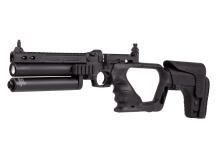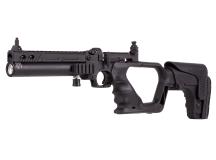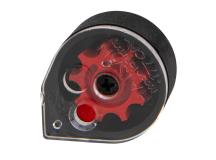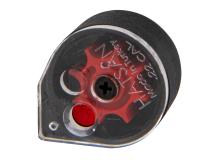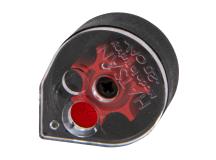Definitive Guide to Hatsan Jet
The Hatsan Jet is a capable pistol that converts easily into a micro-carbine. The tool-free design allows shooters to go from pistol to carbine in less than 10 seconds by simply connecting the rear stock.
In the pistol format, the Hatsan Jet 2 is certainly bulky and can feel a bit off balance. The primary difference between the Jet 1 and Jet 2 is the addition of a 2nd air cylinder. The Jet 1, with a single cylinder, may be a better choice for those who prefer shooting this as a pistol vs. a micro carbine. Conversely, shooters looking for a micro-carbine with more stability and a higher shot count will probably prefer the Jet 2. Given the only real difference between the two models is the additional air cylinder, the rest of this article will focus on our review product, the .22 caliber Jet 2.
The Jet 2 is made from an all-synthetic frame, trigger, action, stock, rail, and grip. The air cylinders, internals, and barrel are metal and tucked very neatly behind all the synthetics. The whole product feels pretty good in the hand as a pistol and also fits nicely into the shoulder when shot as a carbine. There are definitely some rough edges, cast lines, and general cosmetic imperfections throughout, but nothing uncomfortable to hold or use. It's the nature of the design.
Starting from the rear, the pistol has two connection points to receive the rear stock. The buttstock simply clicks into place and provides a solid frame for increased stability. The stock incorporates an adjustable cheekpiece and an AR-style length of pull adjustment. We can certainly see the Jet and Jet 2 being ideal for young shooters who need a short length of pull to achieve proper shooting form.
Moving forward, you'll find the molded ambidextrous grip. It's on the larger side but not so large as to make it unusable for those with smaller hands. In front of the grip, you'll find the non-adjustable plastic trigger. It's made of the same rugged synthetic materials found throughout the Jet, so we suspect that it will hold up just fine over time. It breaks at over 3 pounds but is very predictable. There's a manual safety at the rear of the trigger guard.
Above the trigger, you'll find the side lever action. It's set up to cock with your left hand, allowing your right hand to remain on the grip and trigger. If you're left-handed, you'll have to remove your shooting hand to work the action. Cycling the cocking lever is not as smooth as other products we've tested, but it's rugged and functioned fine in our testing.
On the top of the receiver, you'll find the integrated dual rail that accommodates both weaver mounts and 11mm dovetail mounts. It's a split rail, so you'll need to use two-piece mounts with your optic or ensure that any integrated rail, typically found on red dot sights, is not too long if you prefer it mounted behind the magazine. There's plenty of rail in front of the magazine if you prefer your sight mounted more forward.
Integrated into the integrated rail are flip-up open sights. There are two rearward on the Jet and one at the front. The two rear sights can be used for either pistol or rifle configurations. Ideally, the forward rear sight would be used when in pistol mode, while the rearmost sight would be used when shooting as a carbine. They incorporate fiber optic filaments and are adjustable for elevation only, not windage.
The rail assembly covers the 7.9 inch rifled steel barrel. There are threads at the end of the rail, and Hatsan has included an adaptor to convert them to UNF threads for accessories. This is a great addition.
Below the barrel, you'll find two air cylinders, with the top cylinder housing a pressure gauge and the bottom cylinder providing the foster fill connector. The Jet ships with a foster quick disconnect extension adaptor which we find interesting. Had Hatsan not put a ring around the fill connector, any quick disconnect would work without needing an adaptor. Owners can remove the ring, but that does leave the fill port open to dirt and debris. We found this to be an odd choice.
Setup and Operation
The pistol length is 15 inches. The carbine length ranges from 22.8" to 24.6". As a pistol, the Jet 2 weighs 2.4 pounds, and as a carbine, that increases to 3.4 pounds. The Jet 1 with the single tank will weigh slightly less in both configurations.
The Jet 2 is a PCP airgun, which means you'll need to fill it with high-pressure air to make it go. The Jet 2's optimal fill pressure is 250 bar. Given the small cylinders, the Jet is ideal for those who need to hand pump their PCPs. If you don't have a compressor or a carbon fiber tank but have a hand pump, this is a great option.
Before you start, make sure that you've engaged the safety at the rear of the trigger guard. Once full, you need to load the mag and get ready to fire. Our .22 sample shipped with two 7-round magazines. The .177 version ships with two 8-round magazines, and the .25 version includes two 6-round magazines. To install the mag, pull back on the cocking handle, insert the magazine, and close the cocking handle. When you're ready, release the safety, take aim at your target, and gently squeeze the trigger. To fire again, cycle the cocking handle and repeat.
The Jet 2 certainly has a bark, registering well over 100 DB. This is where you'll be really thankful for the included adaptor. Being able to add a moderator of your choice is a better option than being compelled to live with an included, not removable, option provided by some manufacturers.
Performance and Accuracy
So let's get into the meat of what folks really want to know. How many shots does it get, and how is the accuracy? The Jet and Jet 2 are unregulated PCPs. On paper, the Jet 2 is supposed to get up to 44 shots, with 85% of them in the "optimal" velocity range. The quick and dirty here is that our sample fell way short of those numbers. Starting with a 250-bar fill, we achieved 28 decent shots before finishing below 100 bar. The extreme spread across those four mags was 120 FPS. The high was 756. The low was 636. The average was 704. The extreme spread, as mentioned above, was 120, with a standard deviation of 38.3. It would have been great if our real-world numbers had confirmed the reported stats from Hatsan, but that just was not the case.
If you want more consistency, then refill after two mags, and here's what you'll get. A high of 761. A low of 719. An average of 746 with an extreme spread of only 42 and a standard deviation of 13.9. Those are extremely respectable and more than sufficient for any small-frame PCP pistol.
With that said, accuracy was much better than the numbers on paper would suggest. It's important to remember that the Jet is essentially a pistol and while it can be shot as a micro-carbine, it's still a pistol with a short barrel and limited power.
At 15 yards, the Jet 2 is extremely capable. It has more than enough power for punching paper and even pesting and close-range small game hunting. Here are our results. The first group was shot with the JET 2 as a pistol. The second group was shot as a carbine. Both were shot from a rest.
Summing Up
As we wrap up our look at the Hatsan Jet 1 and Jet 2, it's clear that Hatsan has created a very unique product line. Depending on your shooting preferences, you have a more suitable choice. Pistol shooters can select the Jet 1 for the more streamlined shape and better weight and balance, whereas micro-carbine shooters can go with the Jet 2 for greater stability and higher shot count. And because both come with all the accessories, neither shooter is left without the ability to shoot in either configuration. Additionally, shooters can purchase extra cylinders in various colors to upgrade and expand their JET to their liking.
It's really a fun product that has more than a few practical uses. The compact size and easy fill options make it perfect for backyard target shooting and pesting on a tight budget. The power and shot count of the Jet 2 makes it suitable for squirrel and rabbit hunting inside 25 to 30 yards. And the overall form factor and open sights make it a great option for getting younger shooters into the sport.
If you would like to know more about the Hatsan Jet or Jet 2, please visit our website. Don't hesitate to give us a call with any questions you may have. We are always happy to help.
